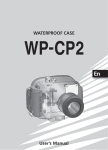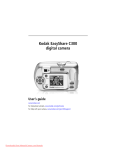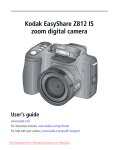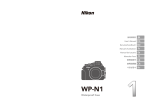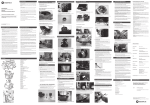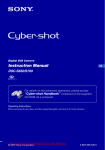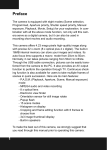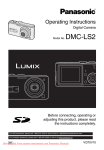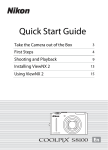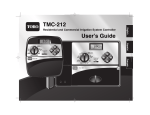Download WATERPROOF CASE User`s Manual
Transcript
WATERPROOF CASE En User’s Manual For Your Safety To prevent damage to your Nikon product or injury to yourself or to others, read the following safety precautions in their entirety before using this equipment. Keep these safety instructions where all those who use the product will read them. The consequences that could result from failure to observe the precautions listed in this section are indicated by the following symbol: This icon marks warnings, information that should be read before using this Nikon product to prevent possible injury. WARNINGS Turn camera off immediately in the event of malfunction Should you notice smoke or an unusual smell coming from the equipment, remove the batteries from the camera immediately, taking care to avoid burns. Continued operation could result in injury. After removing the batteries, take the equipment to a Nikon-authorized service representative for inspection. Do not use in the presence of flammable gas Do not use electronic equipment in the presence of flammable gas, as this could result in explosion or fire. Observe caution when using the strap Never place the strap around the neck of an infant or child. Keep out of reach of children Particular care should be taken to prevent infants from putting small parts into their mouths. Do not disassemble Failure to observe this precaution could result in injury or product malfunction. Should the product break as the result of a fall or other accident, take it to a Nikon-authorized service representative for inspection, being careful not to injure yourself on the broken parts. Observe proper precautions when handling camera batteries If improperly handled, batteries may emit gases that will collect inside the waterproof case, where they may cause explosion or fire. Observe the following precautions when handling camera batteries: • Use a pair of rechargeable Nikon EN-MH1 NiMH batteries, one CRV3 lithium battery, two ZR6 (AA) nickel manganese batteries, or two FR6/L91 (AA) lithium batteries. Do not use other types of battery. Do not mix old and new batteries or batteries of different types. • Batteries are prone to leakage when fully discharged. Remove the camera from the case when not in use. • Should water enter the case, remove the batteries from the camera immediately. • Keep the battery terminals dry. Failure to observe this precaution could result in injury or product malfunction. Do not swallow silica gel or O-ring grease The silica gel desiccant and O-ring grease used in this product are not edible. i Keep out of direct sunlight Do not leave the WP-CP1 in direct sunlight. The case could focus sunlight, causing fire. Do not dive while holding To prevent injury caused by the case striking the body, do not jump or dive into water while holding the WP-CP1. Do not use below 40 m Do not use at depths below 40 m (130´). Failure to observe this precaution could result in leakage or other malfunction. Keep the case watertight Do not clean the case with a high-pressure jet. Do not open the case where it would be exposed to dust or sand, and be sure to remove any foreign objects from the O-ring and any parts of the case that are in contact with the Oring before closing the case. Failure to observe these precautions could result in leakage. ii Do not exposure to high temperatures Do not expose the product to temperatures over 40 °C (104 °F). Failure to observe this precaution could cause the product to warp, resulting in leakage. Observe caution when operating the flash Using the flash close to your subject’s eyes could cause temporary visual impairment. Particular care should be observed if photographing infants, when the flash should be no less than one meter (39˝) from the subject. Cautions To ensure continued enjoyment of your Nikon product, observe the following precautions when storing or using the device. Preventing Leakage WATER INSIDE THE CASE COULD NOT ONLY EXPOSE THE CAMERA TO IRREPARABLE DAMAGE BUT ALSO RESULT IN FIRE, ELECTRIC SHOCK, OR EXPOSURE TO POISONOUS GASES. THE ENTRY OF WATER INTO THE CASE CAN BE PREVENTED BY OBSERVING THE FOLLOWING PRECAUTIONS: Before using the WP-CP1 in or near water, test for leaks as described on pages 6–7 and 12 of this manual. • Before sealing the case, examine the O-ring, watertight channel, and any parts of the case that are in contact with the O-ring carefully to ensure that they are free of dirt, hair, lint, dust, sand, and other foreign objects. Make sure that the O-ring is not twisted or out of position. • The O-ring requires periodic replacement. Replace the O-ring immediately if it is damaged, cracked, warped, or has lost elasticity. O-rings should be replaced at least once a year; do not use a worn O-ring or a type of O-ring or O-ring grease not designated for use in this product. Do not use NIKONOS O-ring lubricant (grease). • Be careful not to damage the O-ring when removing it from the case. Do not use metal objects or objects with sharp points when removing the O-ring. • To prevent wear, use only COOLPIX O-ring grease designated for use with this product. Do not use NIKONOS O-ring lubricant (grease) or other types of O-ring grease. • To not open the waterproof case in areas exposed to spray, high winds, dust, or sand. • Do not drop the case, place under heavy objects, or subject to excessive force. Failure to observe this precaution could cause the case to warp, resulting in leakage. • In the event of leakage, stop use immediately, dry the camera and the interior of the case, and take the camera and case to a Nikon-authorized service representative. Shock and Vibration The waterproof case is not designed to protect the camera from blows or vibration. Do not drop the case, strike it against hard objects, throw it into the water, jump into the water holding the case, or leave the case in an area subject to extreme vibration. Failure to observe these precautions could result in damage to the camera. Maximum Depth The WP-CP1 is waterproof to 40 m (130´). At greater depths, the case could leak, break, or change shape, resulting in damage to the camera. iii Temperature Do not leave the case in areas exposed to high temperatures, such as inside a car, near a heater, on a beach, or in direct sunlight. Failure to observe this precaution could weaken or warp the case, resulting in damage to the camera. Sudden changes in temperature could result in condensation inside the case, which could also damage the camera. To prevent condensation: • Before exposing the case to sudden changes in temperature, place it in a sealed plastic bag. Do not open the bag until the case has reached the same temperature as its surroundings. • Place the supplied desiccant (silica gel) in the case with the camera as directed on page 10 of this manual. • Do not expose the case to high temperatures by leaving it on the beach or in direct sunlight before entering the water. Chemicals • Do not expose the case to volatile chemicals or their vapors. Failure to observe this precaution could result in damage to the case. • Do not use chemical detergents, rust inhibitors, thinner, alcohol, or other volatile chemicals when cleaning the case. Wash in fresh water only. • Use only desiccants designated for use with this product (see page 19). • Use only COOLPIX O-ring grease designated for use with this product (see page 19). Do not use NIKONOS O-ring lubricant (grease). • Do not use sealants or anti-fog chemicals. • Do not handle the case after applying sunscreen. Sunscreen can damage the clear plastic parts of the case. • Do not apply stickers to the case, as the adhesive could cause the case to deteriorate. Travelling by Air If possible, include the case in your carry-on baggage when travelling by air. When packing the case with checked luggage, leave the case open or remove the O-ring. If the case is sealed, changes in air pressure may damage the case or prevent the case from opening. High Altitudes When travelling from high to low altitudes, open the case periodically to equalize the pressure. If the case is kept sealed, changes in air pressure may damage the case or prevent the case from opening. iv Table of Contents For Your Safety ................................................................................................ Cautions ........................................................................................................... Notices.............................................................................................................. i iii vi Introduction Package Contents ............................................................................................ Parts of the WP-CP1 ........................................................................................ Overview .......................................................................................................... 1 1 2 4 Check for Leaks Insert the Camera 1. Ready the Camera ....................................................................................... 2. Insert the Camera ........................................................................................ 3. Insert Desiccant............................................................................................ 4. Perform a Final Check ................................................................................. 5. Close the Case.............................................................................................. Check for Leaks Again Take Pictures 1. Turn the Camera On.................................................................................... 2. Adjust Settings............................................................................................. 3. Take Pictures ................................................................................................ Clean the Case 6 8 8 9 10 10 11 12 13 13 13 14 15 Maintenance Caring for the O-ring ...................................................................................... Storage............................................................................................................. 17 17 19 Technical Notes Specifications ................................................................................................... Optional Accessories ....................................................................................... 19 19 19 v Notices • No part of the manuals included with this product may be reproduced, transmitted, transcribed, stored in a retrieval system, or translated into any language in any form, by any means, without Nikon’s prior written permission. • Nikon reserves the right to change the specifications of the hardware and software described in these manuals at any time and without prior notice. • Nikon will not be held liable for any damages resulting from the use of this product. • While every effort has been made to ensure that the information in these manuals is accurate and complete, we would appreciate it were you to bring any errors or omissions to the attention of the Nikon representative in your area (address provided separately). Important: Before Using This Product Before using this product, be sure that the camera is functioning normally and that the case does not leak ( 6–7, 12). Failure to check for leaks before using the product could result in irreparable damage to the camera, batteries, or memory card. Nikon will not be held liable for damages or lost profits that may result from leakage or product malfunction. Important: Use Only Nikon Brand Electronic Accessories Nikon COOLPIX cameras are designed to the highest standards and include complex electronic circuitry. Only Nikon brand electronic accessories (including battery chargers, batteries, and AC adapters) certified by Nikon specifically for use with this Nikon digital camera are engineered and proven to operate within the operational and safety requirements of this electronic circuitry. For more information about Nikon brand accessories, contact a local authorized Nikon dealer. Life-Long Learning As part of Nikon’s “Life-Long Learning” commitment to ongoing product support and education, continually-updated information is available on-line at the following sites: • For users in the U.S.A.: http://www.nikonusa.com/ • For users in Europe: http://www.europe-nikon.com/support • For users in Asia, Oceania, the Middle East, and Africa: http://www.nikon-asia.com/ Visit these sites to keep up-to-date with the latest product information, tips, answers to frequently-asked questions (FAQs), and general advice on digital imaging and photography. Additional information may be available from the Nikon representative in your area. For contact information, visit http://nikonimaging.com/ vi Introduction To make it easier to find the information you need, the following symbols and conventions are used: This icon marks cautions, information that should be read before use to prevent damage to the camera. This icon marks tips, additional information that may be helpful when using the camera. This icon marks notes, information that should be read before using the camera. This icon indicates that more information is available elsewhere in this manual. Package Contents Take the case and accessories out of the box and check that the package contains all the following items: COOLPIX O-ring grease WP-CP1 (with O-ring in place; check that O-ring is undamaged before use) WP-AN1 strap Spare O-ring Silica gel desiccant (1 package of 5; reseal after opening) Warranty Warranty User’s Manual (this booklet) 1 Introduction Thank you for your purchase of a WP-CP1 waterproof case. The WP-CP1 is waterproof to a depth of 40 m (130´), allowing pictures to be taken underwater or in mist and rain. This manual has been written to help you enjoy taking pictures using compatible Nikon digital cameras (see the camera manual or the websites listed opposite for compatibility information). Read it thoroughly before use, and keep it where all those who use the product will read it. Parts of the WP-CP1 Shutter-release button ( ) Power switch ( 13; ) Introduction Buckle 6, 9, 11) Diffusion panel ( Latch 6, 9, 11) Lens window ( O-ring / O-ring guide ( Rear cover 17) Camera guides ( Watertight channel ( Attaching the Strap 2 14; 9) 10, 17) Front cover O-ring seal ( 10, 17) MENU button ( 13; ) Mode dial ( 13; ) ) button Zoom in (T / ) button ) ( 14; Monitor window ( (delete) button 13; ) Eyelet for strap ( 2) Tripod socket Buckle release button ( 9) Multi selector ( Waterproof case 13; ) Camera multi selector : Performs same function as corresponding camera control. See camera Guide to Digital Photography for details. 3 Introduction Zoom out (W/ ( 14; ) (playback) button ( 14; ) Overview Introduction Using the WP-CP1 Follow these steps when using the waterproof case: Check for Leaks ( 6–7) Important! To prevent water damage to the camera, be sure to check for leaks before placing the camera in the case. If water enters the case, check the O-ring and confirm that the case is properly sealed ( 10). Insert the Camera ( 8–11) 2. Insert the camera 1. Ready the camera 3. Insert desiccant 4. Perform a final check 4 5. Close the case ( Introduction Check for Leaks Again 12) If water enters the case, check the O-ring and confirm that the case is properly sealed ( 10). If the cause of the leak can not be determined, take the case to a Nikon-authorized service representative. Take Pictures ( 13–14) ( 15–16) ( 17–19) 1. Turn the camera on 2. Adjust settings 3. Take pictures Clean the Case 1. 2. 3. 4. 5. 6. Wash the case in fresh water Wipe dry Remove the camera Soak the case in fresh water Wipe dry Let the case dry in the shade Maintenance • Caring for the O-ring • Storage 5 Check for Leaks Check for Leaks Important! Before placing the camera in the case, be sure that the camera is functioning normally and that the case does not leak. Failure to check for leaks before use could result in irreparable damage to the camera. Close the case After making sure that the O-ring is in place, slowly close the case, being careful not to pinch your fingers in the gap. � � Latch the case With front and rear halves of the case lightly touching but the case not fully closed (햲), flip the buckle onto the front half of the case (햳). Press the case closed until the latch clicks shut. Check that the case is properly sealed, that the O-ring is in place, and that no foreign objects are caught in the seal. Immerse the case Slowly immerse the case in water, stopping if water enters the case. Test the case in a shallow area (1 m / 3´ or less) or in a tub or bucket. Do not use hot water, as this could exceed the operating temperature range of 0–40 °C (32–104 °F). 6 Test the shooting controls Immerse the case and operate the controls underwater for two to three minutes, checking whether any bubbles are emitted or any water enters the case. Check for water inside the case Take the case out of the water and check for water inside the case. If water has entered the case, check the O-ring ( 10, 17–18). If the cause of the leak can not be determined, take the case to a Nikon-authorized service representative. After checking for leaks, dry the case thoroughly before inserting the camera. 7 Check for Leaks Check for leaks Keep the case immersed and check whether any bubbles are emitted. After two to three seconds, take the case out of the water and check whether any droplets are inside. Insert the Camera Insert the Camera 1. Ready the Camera Insert the batteries and memory card Before using the camera, check the battery level and number of exposures remaining. Batteries Make sure that the batteries are undamaged, are from the same pair, and have the same charge. Do not use damaged batteries or mix old and new batteries, batteries of different makes, or batteries with different charges. Failure to observe these precautions could result in fire or in damage to the batteries. For more information, see the camera Guide to Digital Photography. Remove the Camera Strap To ensure that the camera strap does not get caught in the seal and cause a leak, be sure to remove the strap before placing the camera in the case. 8 2. Insert the Camera � � Release the buckle Pressing the buckle release button (햲), slide the latch forward (햳) and open the buckle (햴). � � � � Open the case Opening the Case Do not open the case in areas exposed to blown sand or spray. Keep the case upright; do not place the open case with the O-ring or O-ring seal face down. Insert the camera Position the camera in the camera guides with the lens in the lens window. 9 Insert the Camera Turn the camera off 3. Insert Desiccant Insert the Camera To prevent condensation from forming inside the case, insert the silica gel desiccant between the bottom of the camera and the case. Slide the desiccant to the front of the case, where it will not interfere with proper closing of the case. Improper placement could cause the case to leak. Replacing the Desiccant Used desiccant loses its ability to absorb moisture. We recommend replacing the desiccant each time the case is used ( 19). 4. Perform a Final Check • Is the O-ring cracked or damaged? • Is the O-ring twisted or out of position? • Is the O-ring free of hair, dust, sand, and other foreign objects? Is the desiccant correctly placed? 10 • Is the camera in the correct orientation? • Has the camera strap been removed? Are the O-ring seal and watertight channel free of hair, dust, sand, and other foreign objects? 5. Close the Case � � Latch the case With front and rear halves of the case lightly touching but the case not fully closed (햲), flip the buckle onto the front half of the case (햳). Press the case closed until the latch clicks shut. Check that the case is properly sealed, that the O-ring is in place, and that no foreign objects are caught in the seal. 11 Insert the Camera Close the case After making sure that the O-ring is in place, slowly close the case, being careful not to pinch your fingers in the gap. Check for Leaks Again Check for Leaks Again Important! Before use, be sure that the camera is functioning normally and that the case does not leak. Failure to check for leaks before use could result in irreparable damage to the camera. After sealing the case, perform a final check for leaks. Immerse the case in water and check for leaks as described in Steps 3–6 of “Check the Case for Leaks” ( 6). Check that the desiccant stays dry and that no water enters the case. If a leak is detected, immediately remove the case from the water, dry the camera and case thoroughly, and check that the O-ring is intact and the case properly sealed. If the cause of the leak can not be determined, take the case to a Nikon-authorized service representative. 12 Take Pictures 1. Turn the Camera On Press the power switch on the waterproof case. The camera power-on lamp will light and the monitor will turn on. 2. Adjust Settings The controls on the case correspond to the following camera controls. For more information, see the camera Guide to Digital Photography. Mode dial * Zoom buttons MENU button Multi selector (delete) button (playback) button * Direction of rotation is reversed. 13 3. Take Pictures Take Pictures Ready the camera Hold the case steadily in both hands. Don’t Block the Shot Keep fingers and other objects away from the lens window and diffusion panel. Frame the picture Use the zoom buttons on the case to frame the subject in the monitor. Zoom out Zoom in Use the Monitor The viewfinder can not be used when the camera is in the case. Use the monitor to frame pictures. Focus and shoot Press the shutter-release button on the case halfway to focus. Smoothly press the button the rest of the way down to shoot. Pictures can be played back using the button on the case. Underwater Photography The best time for underwater photography is when the sun is directly overhead (note that pictures taken underwater may have a blue cast). While shooting, avoid exhaling bubbles into the frame. Close-up shots can be taken at ranges of as little as 4 cm (1.6˝) when the camera is zoomed out to where the icon in the monitor turns green. Note that the flash may be unable to light the entire subject when the camera is zoomed out, while the range of the flash may vary with depth and the transparency of the water. Reactivating the Monitor If the monitor has turned off to save power, it can be reactivated by pressing the power button or by pressing the shutter-release button halfway. By default, the monitor will turn off automatically if no operations are performed for one minute. The length of time the monitor remains active can be adjusted using the Auto off option in the camera setup menu. 14 Clean the Case Wipe dry Dry the exterior of the case thoroughly with a soft, dry cloth. Drying the Case Be careful to remove water that may have collected in the buckle, controls, or strap eyelet. Remove the camera Remove the camera and dry the inside of the case with a soft, dry cloth. Removing the Camera Do not open the case in areas exposed to blown sand or spray. When removing the camera, be careful not to drop the device and make sure that droplets from your hair, body, or other objects do not fall into the case or onto the camera. If water does fall on the camera, dry it off immediately. Keep the case upright; do not place the open case with the O-ring or O-ring seal face down. Soak the case in fresh water Reseal the case and leave it in a basin of fresh water for two to three hours. Operate each of the controls a few times to remove salt. If salt drys on the controls, they may cease to function or their metal parts may rust, causing leakage. 15 Clean the Case Wash the case in fresh water The case should be cleaned immediately after use. Before opening the case and removing the camera, wash the case in a basin of fresh water. Clean the Case Wipe dry Dry the case thoroughly with a soft, dry cloth. Do not use a cloth to which salt has adhered. Let the case dry in the shade Leave the case out to dry in a shady, well-ventilated area. Do Not Exposure to Sunlight or Heat Do not use a hair dryer or other heat source or place the case in direct sunlight. Heat could cause the O-ring to deteriorate, resulting in leakage. Cleaning the Interior of the Case Use a blower or a soft, dry cloth to clean the interior of the case. Do not use water, detergents, or chemical agents of any kind. Water can damage the coating on the inside of the lens window. 16 Maintenance Caring for the O-ring The WP-CP1 uses an O-ring to form a watertight seal. Improper handling of the O-ring can produce leaks. Check the condition of the O-ring as described below before each use, and check for the presence of foreign matter on the O-ring each time the case is opened, however briefly. Remove the O-ring Pinch the O-ring lightly between two fingers to form a loop. Take hold of the loop and remove the O-ring from the case. Removing the O-ring Using fingernails, metal tools, or sharp or pointed objects to remove the O-ring could damage the ring, causing leakage. Cracking Inspect the O-ring Remove old O-ring grease and other foreign matter with tissue paper or a soft, dry cloth, taking care not to leave tissue or threads on the O-ring. Gently bend the O-ring to check for cracking or other damage. Inspect the O-ring guide Use a blower or cotton swab to remove any foreign objects from the watertight channel and all parts of the case that come into contact with the O-ring. Be sure to remove any threads left behind by the swab. Replacing the O-ring The O-ring requires periodic replacement. Replace the O-ring immediately if it is damaged, cracked, warped, or has lost its elasticity. O-rings should be replaced at least once a year. Use only COOLPIX O-ring grease designated for use in this product; replacement O-rings and O-ring grease can be purchased from a Nikon camera retailer or Nikon-authorized service agent. Do not use NIKONOS O-ring lubricant (grease). 17 Maintenance Grease the O-ring If the O-ring is not properly greased, it may crack or peel, causing leaks. If the bottom of the O-ring appears dry, place a drop of O-ring grease on your index finger and spread grease on the O-ring by sliding it between your thumb and index finger, gently stretching the ring. Do not use cloth or paper, as these may leave fibers on the O-ring. Note that applying too much grease may cause foreign matter to adhere more readily to the ring, preventing the case from sealing properly. Replace the O-ring Making sure the O-ring and guide are free of foreign objects, place the O-ring so that it runs evenly at the same level all the way round the Oring guide, without undue stretching and without protruding from the guide. Check the seal Close the case and check that the case is fully sealed. If the O-ring does not form a perfect seal, open the case and adjust the O-ring to prevent leaks. Cleaning Do not use detergents or volatile chemicals such as alcohol or thinner when cleaning the case. Failure to observe this precaution could result in damage to the case or Oring. 18 Storage Technical Notes Specifications Maximum depth 40 m (130´) Camera operating temperature 0–40 °C (32–104 °F) Dimensions 128 × 97 × 73.5 mm/5.04˝ × 3.82˝ × 2.89˝ (W × H × D) Approximate weight 260 g (9 oz) when empty Optional Accessories O-ring set WP-OG1 O-ring set (contains WP-O1 O-ring and WP-G1 O-ring grease) Desiccant WP-S1 silica gel desiccant Servicing Nikon recommends that the case be serviced by a Nikon-authorized service representative at least once a year. A fee is charged for this service. 19 Maintenance/Technical Notes Store the case in a cool, well-ventilated area, leaving the case open to prevent the O-ring from deteriorating. When leaving the case unused for an extended period, remove the O-ring, wipe off any O-ring grease, and place the O-ring in a clean plastic bag to ensure that it maintains it elasticity. Do not store the case in direct sunlight or where it will be exposed to sudden changes in temperature or high levels of humidity. Do not store the case or O-ring under other objects, close to open flames, in the vicinity of flammable items, or with naptha or camphor moth balls.


























